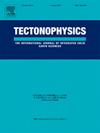Break-off and stagnation of the subducting Nazca slab in the mantle transition zone beneath West-Central South America
IF 2.6
3区 地球科学
Q2 GEOCHEMISTRY & GEOPHYSICS
引用次数: 0
Abstract
The eastward subduction of the Nazca Plate beneath the South American continent forms the Andean subduction zone, while deep mantle dynamics associated with slab-entrained mantle flow, thermal structure, and geometry of the subducted slab remain debated. In this study, we have utilized a total of 49,237 receiver functions recorded by 669 stations in West-Central South America to map the variations in topography of the mantle transition zone (MTZ) discontinuities and elucidate their causes. Simultaneous depressions in apparent depths of MTZ discontinuities beneath the northern Andean Orogen are attributed to subduction-driven entrained mantle flow that generates low seismic velocity anomalies within the upper mantle. In contrast, joint analysis of detected MTZ thinning and high-velocity anomalies under the Andean Orogen (south of 26o S) reveals a slab break-off segment within the MTZ. The uplift of the 410 km discontinuity confirms penetration of the subducting Nazca slab into the MTZ. Notably, significant MTZ thickening (primarily engendered by the depression of the 660 km discontinuity) is deciphered under the Central South American continent and indicates stagnation of subducted slab segments at the bottom of the MTZ.
南美中西部地幔过渡带俯冲纳斯卡板块的断裂与停滞
纳斯卡板块在南美大陆下的向东俯冲形成了安第斯俯冲带,而与板块夹带地幔流、热结构和俯冲板块几何形状相关的深部地幔动力学仍存在争议。在这项研究中,我们利用南美洲中西部669个台站记录的49237个接收函数,绘制了地幔过渡带(MTZ)不连续性的地形变化,并阐明了其原因。北安第斯造山带下MTZ不连续表面深度的同时凹陷归因于俯冲驱动的夹带地幔流,该流在上地幔内产生低地震速度异常。相比之下,对安第斯造山带(26o S以南)下检测到的MTZ减薄和高速异常的联合分析显示,MTZ内存在板块断裂段。410 km不连续面的隆起证实了俯冲纳斯卡板块向MTZ的渗透。值得注意的是,在中南美洲大陆下方发现了明显的MTZ增厚(主要是由660 km不连续的凹陷造成的),表明MTZ底部的俯冲板块段停滞不前。
本文章由计算机程序翻译,如有差异,请以英文原文为准。
求助全文
约1分钟内获得全文
求助全文
来源期刊

Tectonophysics
地学-地球化学与地球物理
CiteScore
4.90
自引率
6.90%
发文量
300
审稿时长
6 months
期刊介绍:
The prime focus of Tectonophysics will be high-impact original research and reviews in the fields of kinematics, structure, composition, and dynamics of the solid arth at all scales. Tectonophysics particularly encourages submission of papers based on the integration of a multitude of geophysical, geological, geochemical, geodynamic, and geotectonic methods
 求助内容:
求助内容: 应助结果提醒方式:
应助结果提醒方式:


